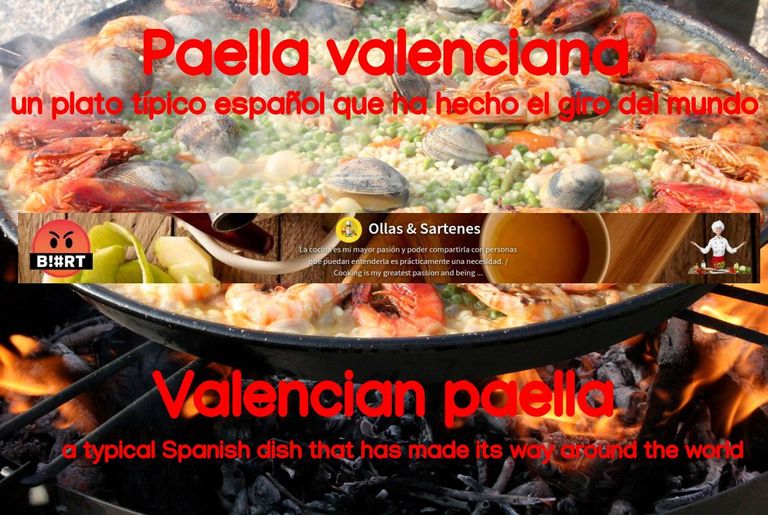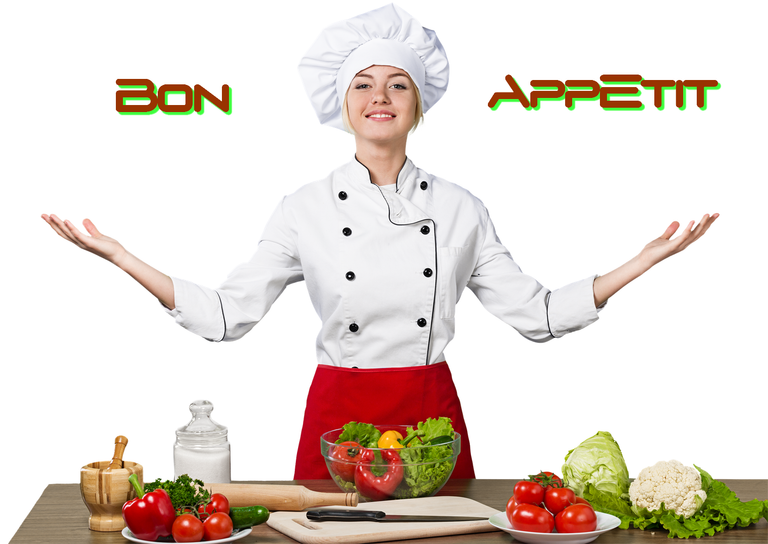
Aquí tienes una receta que ha dado la vuelta al mundo.
Este plato nacional español ha conquistado el mundo y es una comida realmente completa.
Se prepara en una sartén grande con dos asas, ancha y alta en los bordes.

Here is a recipe that took the world by storm.
This national Spanish plate has conquered the world and is a truly complete meal.
It is prepared in a large sartén with two sides, even and high in the edges.
Receta para personas n. 6 / Recipe for people n. 6

- 500 g de arroz de grano largo (sancochado, patna o basmati)
- 2 pimientos rojos
- 1 cebolla grande
- 1 diente de ajo
- 300 g de guisantes sin cáscara
- 1 pollo pequeño cortado en trozos
- 200 g de lomo de cerdo (o salchicha)
- 1 trozo de chorizo (u otro embutido seco picante local)
- 200 g de lonchas de calamar o sepia ya limpias
- 400 g de almejas y/o mejillones
- 6 o 12 colas de gambas sin pelar
- 300 g de pulpa de tomate (fresco o enlatado)
- 1 sobre de azafrán
- 1 cucharadita de pimentón dulce
- 1 hoja de laurel,
- caldo de carne
- sal
- pimienta negra
- 6 cucharadas de aceite de oliva.

- 500 g of broad wheat roast (sancochado, patna or basmati)
- 2 red pimientos
- 1 large cebolla
- 1 day of food
- 300 g of pork rinds without bone
- 1 small chicken cut into three pieces
- 200 g of cerdo lomo (or salchicha)
- 1 piece of chorizo (one other stuffed with local spicy sauce)
- 200 g of calamar or sepia loins cleaned
- 400 g of almejas and/or mejillones
- 6 or 12 colas de gambas without peel
- 300 g tomato pulp (fresh or sliced)
- 1 above blue
- 1 teaspoon of sweet pimentón
- 1 hoja de laurel,
- heat of meat
- sal
- black pimienta
- 6 tablespoons of olive oil.

30', más enfriamiento e infusión. / 30', more cooling and infusion.
- Dejar las almejas en agua con sal durante 3 horas para que suelten la arena.
- Primero se deben cepillar los mejillones con agua corriente.
- Cortar la carne de cerdo en cubos o pelar la salchicha y partirla en trozos pequeños.
- Picar la cebolla y el ajo juntos. Pelar los pimientos y cortarlos en tiras.
- Cortar la salchicha picante en rodajas.
- Hacer un corte en el lomo de las gambas y retirar la tripa intestinal sin quitar la cáscara.

- Leave the fish in the water with salt for 3 hours to remove the sand.
- First, brush the balls with running water.
- Cut the venison meat into cubes or peel the sausage and divide it into three pieces.
- Pick the bowl and the joints. Peel the peppers and cut them in strips.
- Shorten the spicy sausage in rodajas.
- Make a cut on the back of your legs and remove the intestinal waste without quitting the waste.

- Calentar el horno a 250°.
- Vierte la mitad del aceite en la sartén de hierro adecuada (si no tienes, puedes usar un wok, o cualquier recipiente que pueda pasar al fuego y al horno) y calienta a fuego medio.
- Dorar los trozos de pollo por todos lados y añadir sal al final.
- Retíralos y mantenlos calientes.
- En la misma sartén sofreímos la cebolla y el ajo con la hoja de laurel y añadimos el lomo o chorizo.
- Cuando la carne esté dorada añadir los pimientos y los calamares cortados en tiras.
- Pasados unos minutos añadimos el tomate y los guisantes y dejamos cocer unos minutos.
- Retire estos ingredientes de la sartén y vierta el aceite restante.
- Tuesta el arroz rápidamente y añade todos los demás ingredientes, incluidas las especias y una cucharada de sal.
- Cubrir con aproximadamente 1 litro y cuarto de caldo, mezclar bien y llevar todo a ebullición.
- Cubrir con papel aluminio y cocinar en el horno durante unos 15 minutos sin revolver.
- Comprueba al final que el arroz está cocido y, si es necesario, añade un poco de caldo si parece que el arroz está demasiado seco.
- Lleva la paella a la mesa en su recipiente.

- Heat the horn to 250°.
- Place the pan on the right pan (if you don't have it, you can use a wok, or any other container that can heat the flame and heat) and heat to medium heat.
- Brown the chicken pieces on all sides and add to the finish.
- Keep them warm and keep them warm.
- At the same time, let's fry the chicken and the garlic with the laurel hoja and add the lomo or chorizo.
- When the meat is browned, add the pimientos and the calamari cut into strips.
- After one minute we add the tomato and sauce and let us cook one minute.
- Remove these ingredients from the sauce and remove the remaining vinegar.
- Roast this quickly and add all the other ingredients, including the spices and a spoonful of salt.
- Cook with approximately 1 liter and a quarter of heat, mix well and remove all the boiling.
- Cover with aluminum foil and cook on the stove for 15 minutes without a revolver.
- Finally, check that the roast is cooked and, if necessary, add a little heat if it seems that the roast is left with it.
- Take the paella to the table in a container.
La paella es quizás el plato más conocido de la rica y variada gastronomía española. Es una preparación culinaria muy conocida a nivel internacional y fácil de encontrar en las cartas de miles de restaurantes de todo el mundo. Sin embargo, curiosamente, el desconocimiento de la auténtica receta de la paella es generalizado.
Aquí podrás encontrar una receta fiable de auténtica paella valenciana, teniendo en cuenta que quien firma estas líneas, además de valenciano, es cocinero de profesión y vocación.

Paella is the most well-known dish of the rich and varied Spanish gastronomy. It is a culinary preparation well known internationally and easy to find on the menus of thousands of restaurants around the world. However, curiously, the misconception of the authentic paella recipe is generalized.
Here you will be able to find a fairytale recipe of authentic Valencian paella, keeping in mind that the person who signs these lines, also Valencian, is the cook of profession and vocation.
Un poco de historia. / A little story.
Se supone que el consumo de arroz en Valencia se limitaba inicialmente al en forma de harina o sémola. En el siglo XVI ya se consumía en Valencia el arroz cocido en cazuela de barro y, a partir del siglo XVIII, ya hay noticias del plato conocido como paella.
El origen de la paella, como todos los platos de la cocina popular de una zona concreta, no es otro que la unión de los elementos que cada país tenía a disposición en su entorno. En la zona de Valencia existía y existe (aunque cada vez menos) una rica zona de huertas de regadío que proporcionaban hortalizas frescas a sus habitantes.
También era común criar gallinas y conejos para el consumo familiar; el entorno de la Albufera y los arrozales vecinos aportaban el arroz y ofrecían la posibilidad de añadir de vez en cuando algunos elementos cinegéticos a la paella.
Si a esta fabulosa despensa le sumamos pescados y mariscos de zonas costeras, además de aceite de oliva de la zona mediterránea, tenemos todos los ingredientes con los que se elaboran la mayoría de paellas clásicas. Sólo nos faltará una cosa más, el recipiente para cocinarlas. Y este envase no es otro que la paella.
"Paella", sí, y no "paellera" como dicen en otras zonas de España o en la propia Comunidad Valenciana.

It is assumed that the consumption of roast in Valencia was initially limited to the form of harina or semolina. In the 16th century the roast cooked in a barley casserole was consumed in Valencia and, starting from the 18th century, there were news from the dish known as paella.
The origin of the paella, like all the dishes of the popular cuisine of a specific area, is no other than the union of the elements that each country had available in its surroundings. In the Valencia area there is and exists (at least sometimes) a rich area of reputable food that offers fresh vegetables to its inhabitants.
It was also common to raise chickens and conejos for family consumption; the surroundings of the Albufera and the old arrozales bring the arroz and offer the possibility of adding it again when some cinematic elements are added to the paella.
If in this fabulous dish we dispense the sum of fish and seafood from the coastal areas, as well as olive oil from the Mediterranean area, we keep all the ingredients with those who prepare most classic paellas. Only we will do one thing more, the cooking container. This package is nothing other than paella.
"Paella", yes, and not "paellera" as they say in other areas of Spain or in your own Valencian Community.
Fuentes de la/s imàgen/es / Sources image/s:
Imagen inicial / Initial image: Pixabay by EstudioWebDoce.
Imagen final / Final image: Pixabay by herminiato.
Y como siempre me despido de todos con un:
And as always I bid you all farewell with a:
